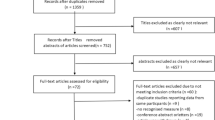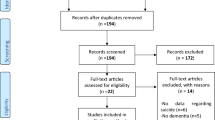Abstract
Stroke is known to be associated with an increase in the risk for suicide. However, there are very few population-based studies investigating the risk of suicidal ideation and attempts in patients with stroke. The purpose of this study was to compare the risk of suicidal ideation and attempts between patients with stroke and population without stroke using nationwide survey data. Individual-level data were obtained from 228,735 participants (4560 with stroke and 224,175 without stroke) of the 2013 Korean Community Health Survey. Demographic characteristics, socioeconomic status, physical health status, and mental health status were compared between patients with stroke and population without stroke. Multivariable logistic regression was performed to investigate the independent effects of the stroke on suicidal ideation and attempts. Stroke patients had more depressive mood (12.6 %) than population without stroke (5.7 %, p < 0.001). Stroke patients experienced more suicidal ideation (24.4 %) and attempts (1.3 %) than population without stroke (9.8 and 0.4 %, respectively; both p < 0.001). Stroke was found to increase the risk for suicidal ideation (OR 1.65, 95 % CI 1.52–1.79) and suicidal attempts (OR 1.64, 95 % CI 1.21–2.22), adjusting for demographics, socioeconomic factors, and physical health and mental health factors. We found that stroke increased the risk for suicidal ideation and attempts, independent of other factors that are known to be associated with suicidality, suggesting that stroke per se may be an independent risk factor for suicidality.
Similar content being viewed by others
References
Gaete JM, Bogousslavsky J (2008) Post-stroke depression. Expert Rev Neurother 8:75–92
Nilsson I, Jansson L, Norberg A (1999) Crisis phenomena after stroke reflected in an existential perspective. Int J Aging Hum Dev 49:259–277
Kishi Y, Kosier JT, Robinson RG (1996) Suicidal plans in patients with acute stroke. J Nerv Ment Dis 184:274–280
Pompili M, Venturini P, Campi S, Seretti ME, Montebovi F, Lamis DA et al (2012) Do stroke patients have an increased risk of developing suicidal ideation or dying by suicide? An overview of the current literature. CNS Neurosci Ther 18:711–721
Fuller-Thomson E, Tulipano MJ, Song M (2012) The association between depression, suicidal ideation, and stroke in a population-based sample. Int J Stroke 7:188–194
Santos CO, Caeiro L, Ferro JM, Figueira ML (2012) A study of suicidal thoughts in acute stroke patients. J Stroke Cerebrovasc Dis 21:749–754
Stenager EN, Madsen C, Stenager E, Boldsen J (1998) Suicide in patients with stroke: epidemiological study. BMJ 316:1206
Teasdale TW, Engberg AW (2001) Suicide after a stroke: a population study. J Epidemiol Community Health 55:863–866
Yamauchi T, Inagaki M, Yonemoto N, Iwasaki M, Inoue M, Akechi T et al (2014) Death by suicide and other externally caused injuries after stroke in Japan (1990–2010): the Japan Public Health Center-based prospective study. Psychosom Med 76:452–459
Dou J, Tang J, Lu CH, Jiang ES, Wang PX (2015) A study of suicidal ideation in acute ischemic stroke patients. Health Qual Life Outcomes 13:7
Office KNS (ed) (2011) 2010 Annual report on the Cause of Death. Korean National Statistical Office, Seoul
Hong KS, Bang OY, Kang DW, Yu KH, Bae HJ, Lee JS et al (2013) Stroke statistics in Korea: part I. Epidemiology and risk factors: a report from the korean stroke society and clinical research center for stroke. J Stroke 15:2–20
Lim SJ, Kim HJ, Nam CM, Chang HS, Jang YH, Kim S et al (2009) Socioeconomic costs of stroke in Korea: estimated from the Korea national health insurance claims database. J Prev Med Public Health 42:251–260
Rim H, Kim H, Lee K, Chang S, Hovell MF, Kim YT et al (2011) Validity of self-reported healthcare utilization data in the Community Health Survey in Korea. J Korean Med Sci 26:1409–1414
Nock MK, Borges G, Bromet EJ, Alonso J, Angermeyer M, Beautrais A et al (2008) Cross-national prevalence and risk factors for suicidal ideation, plans and attempts. Br J Psychiatry 192:98–105
Kessler RC, Borges G, Sampson N, Miller M, Nock MK (2009) The association between smoking and subsequent suicide-related outcomes in the National Comorbidity Survey panel sample. Mol Psychiatry 14:1132–1142
Pfaff JJ, Almeida OP, Witte TK, Waesche MC, Joiner TE Jr (2007) Relationship between quantity and frequency of alcohol use and indices of suicidal behavior in an elderly Australian sample. Suicide Life Threat Behav 37:616–626
Brown DR, Galuska DA, Zhang J, Eaton DK, Fulton JE, Lowry R et al (2007) Psychobiology and behavioral strategies. Physical activity, sport participation, and suicidal behavior: US high school students. Med Sci Sports Exerc 39:2248–2257
Druss B, Pincus H (2000) Suicidal ideation and suicide attempts in general medical illnesses. Arch Intern Med 160:1522–1526
Coups EJ, Ostroff JS (2005) A population-based estimate of the prevalence of behavioral risk factors among adult cancer survivors and noncancer controls. Prev Med 40:702–711
Haskell WL, Lee IM, Pate RR, Powell KE, Blair SN, Franklin BA et al (2007) Physical activity and public health: updated recommendation for adults from the American College of Sports Medicine and the American Heart Association. Circulation 116:1081–1093
Idler EL, Benyamini Y (1997) Self-rated health and mortality: a review of twenty-seven community studies. J Health Soc Behav 38:21–37
Gigantesco A, Morosini P (2008) Development, reliability and factor analysis of a self-administered questionnaire which originates from the World Health Organization’s Composite International Diagnostic Interview—Short Form (CIDI-SF) for assessing mental disorders. Clin Pract Epidemiol Ment Health 4:8
Gaynes BN, West SL, Ford CA, Frame P, Klein J, Lohr KN et al (2004) Screening for suicide risk in adults: a summary of the evidence for the US Preventive Services Task Force. Ann Intern Med 40:822–835
Kishi Y, Robinson RG, Kosier JT (1996) Suicidal plans in patients with stroke: comparison between acute-onset and delayed-onset suicidal plans. Int Psychogeriatr 8:623–634
Pohjasvaara T, Vataja R, Leppavuori A, Kaste M, Erkinjuntti T (2001) Suicidal ideas in stroke patients 3 and 15 months after stroke. Cerebrovasc Dis 12:21–26
Eriksson M, Glader EL, Norrving B, Asplund K (2015) Poststroke suicide attempts and completed suicides: a socioeconomic and nationwide perspective. Neurology 84:1732–1738
Forsstrom E, Hakko H, Nordstrom T, Rasanen P, Mainio A (2010) Suicide in patients with stroke: a population-based study of suicide victims during the years 1988–2007 in northern Finland. J Neuropsychiatry Clin Neurosci 22:182–187
Flaster M, Sharma A, Rao M (2013) Poststroke depression: a review emphasizing the role of prophylactic treatment and synergy with treatment for motor recovery. Top Stroke Rehabil 20:139–150
Pompili M, Venturini P, Lamis DA, Giordano G, Serafini G, Belvederi Murri M et al (2015) Suicide in stroke survivors: epidemiology and prevention. Drugs Aging 32:21–29
Arango V, Underwood MD, Gubbi AV, Mann JJ (1995) Localized alterations in pre- and postsynaptic serotonin binding sites in the ventrolateral prefrontal cortex of suicide victims. Brain Res 688:121–133
Nishida N, Hata Y, Yoshida K, Kinoshita K (2015) Neuropathologic features of suicide victims who presented with acute poststroke depression: significance of association with neurodegenerative disorders. J Neuropathol Exp Neurol 74:401–410
Tang WK, Lu JY, Mok V, Ungvari GS, Wong KS (2011) Is fatigue associated with suicidality in stroke? Arch Phys Med Rehabil 92:1336–1338
Tang WK, Liang H, Mok V, Ungvari GS, Wong KS (2013) Is pain associated with suicidality in stroke? Arch Phys Med Rehabil 94:863–866
Tang WK, Lu JY, Liang H, Chan TT, Mok V, Ungvari GS et al (2011) Is insomnia associated with suicidality in stroke? Arch Phys Med Rehabil 92:2025–2027
Paolucci S, Ngeh J (2015) Suicide in stroke survivors: frequency and risk factors. Neurology 84:1724–1725
Varnik P (2012) Suicide in the world. Int J Environ Res Public Health 9:760–771
Kwon JW, Chun H, Cho SI (2009) A closer look at the increase in suicide rates in South Korea from 1986–2005. BMC Public Health 9:72. doi:10.1186/1471-2458-9-72
Sokero TP, Melartin TK, Rytsala HJ, Leskela US, Lestela-Mielonen PS, Isometsa ET (2005) Prospective study of risk factors for attempted suicide among patients with DSM-IV major depressive disorder. Br J Psychiatry 186:314–318
Acknowledgments
This work was supported by research fund of Catholic Kwandong University International St. Mary`s Hospital (CKURF-0005).
Author information
Authors and Affiliations
Corresponding author
Ethics declarations
Conflicts of interest
The author declares no conflict of interest.
Ethical standards
This study was approved by the institutional review board at the Korea Centers for Disease Control and Prevention (2013-06EXP-01-3C) and has, therefore, been performed in accordance with the ethical standards laid down in the 1964 Declaration of Helsinki. Written informed consent was obtained from all subjects prior to their inclusion in this study.
Additional information
J. H. Chung and J. B. Kim contributed equally to this work.
Rights and permissions
About this article
Cite this article
Chung, J.H., Kim, J.B. & Kim, J.H. Suicidal ideation and attempts in patients with stroke: a population-based study. J Neurol 263, 2032–2038 (2016). https://doi.org/10.1007/s00415-016-8231-z
Received:
Revised:
Accepted:
Published:
Issue Date:
DOI: https://doi.org/10.1007/s00415-016-8231-z




